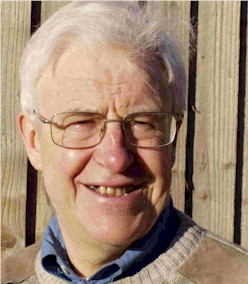
Cycling in
Rural
China
Part 1
Copyright © Michael G. Ormerod, 2005.
Cycling in Rural China: Part 1 | Part 2 | Part 3 | Part 4 | Part 5
"I have always wanted to cycle in rural China."
"Let's do it then!"
This conversation with Graham was in January, 2005. After some research, I found a company in Chengdu called Bike China Adventures. We opted for a 'challenging' ride around Yunnan province in south-west China for two weeks in October.
Yunnan province
Yunnan is home to 25 of China's 56 ethnic minorities. The older women still wear their traditional dress. The area we explored is alpine - hence the description of the ride as 'challenging.' We frequently were climbing for anything up to 12 miles to cross over a pass into the next valley.
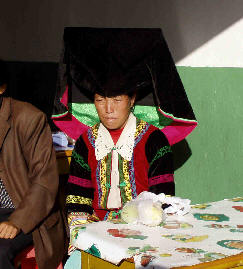
Woman in traditional Yi dress.
More photographs of women in ethnic dress, click here.
As we passed through the countryside, the poverty was in striking contrast to the prosperity evident in the cities (such as Chengdu in neighbouring Sichuan). There was little machinery; nearly everything was done by hand.
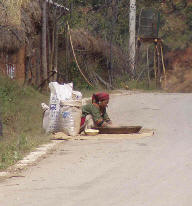
Winnowing rice
At the tourist sites, most of the sightseers are Chinese - the new middle class,
created by the move to a market economy.
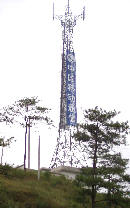
Another striking feature is the widespread ownership of mobile telephones. The cover is excellent. In the most isolated areas, I could always pick up a signal - due to the large mobile phone masts on the tops of many of the hills. The state companies presumably do not have to apply for planning permission!
With the market economy so evident, it was a surprise to see Chairman Mao's picture on the wall in small restaurants. I tended to forget that I was in a Communist country.
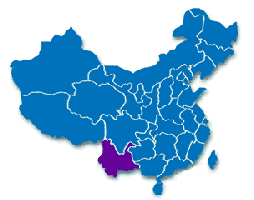
For more information on Yunnan, click here.
Another aspect that struck me was women working as labourers. The Yi men and women seemed to be sharing the labour in the fields but amongst the Tibetan and Naxi minorities, the women appeared to be carrying out more than their fair share of hard labour.
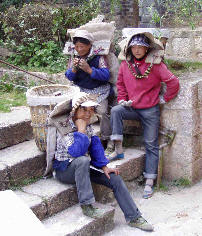
Women in Lijiang
Roads in China
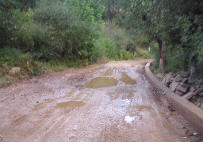
The main roads in the cities and those linking major cities have a good surface. However, if there is any obstruction, such as a landslide (fairly common in this mountainous area), the authorities are slow to do more than clear one lane. Road works are poorlymarked - no more than a small red flag on the obstruction.
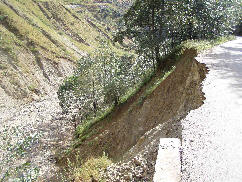
Not the place to meet two lorries, overtaking one another!
In the cities, there are cycle tacks alongside the main roads. Often they are separated from the traffic by a physical barrier. However, you still have to contend withpedestrians, mopeds and other cyclists, sometimes cycling in the wrong direction.
Another hazard are small minibuses which will put down and pick up passengers anywhere along their route. They stop in the road and the passengers step out in front of you, either from the bus or from the pavement.
Rural roads vary from a reasonable tarmac surface to something akin to a badly maintained cart track. The surface is cobbled on many of the hills, which makes for difficult cycling. An MTB is essential.
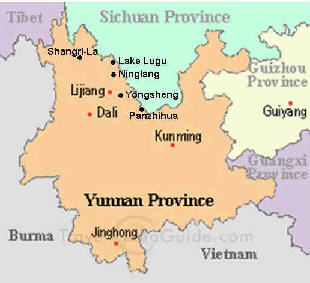
Accommodation & food
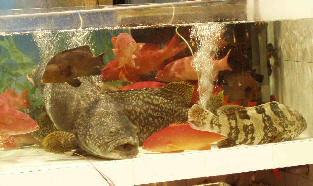
What's on the menu? Sea food restaurant in Sai Kung
Most of the time, we stayed in 3-star Chinese hotels - often state-owned. The rooms had en suite facilities with western style toilets. The food was uncompromisingly Chinese.
We ate well; often in small roadside restaurants. The food was always fresh. Our Chinese guide, Danny, would check out the supply of fresh vegetables and meat and then order our meal. We often watched it being cooked. Yunnan cuisine uses a lot of chillies. It was best to pick out the small fiery peppers if you wanted to taste the rest of the meal.
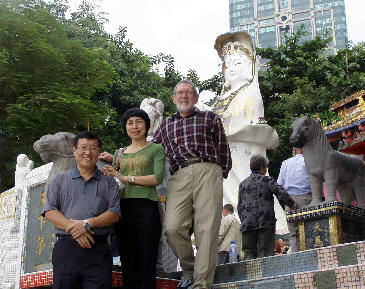
Jenny, George & Graham by the Empress of the Sea
And now the holiday!
The first few days
We spent the first day of the holiday in Hong Kong with two old friends of mine, George and Jenny Tsao. The highlights of the day were Dim Sum in the Jumbo floating restaurant and a dinner of sea food in Sai Kung.
The next day, we took the Turbojet from Kowloon to Shenzhen in mainland China. A short flight took us to Kunming, where we were met by Danny, our Chinese guide. At the hotel, we met our other companion for the trip, Jody. She is an American whose husband is working in Shanghai for six months. Jody is super fit and always arrivedat the top of the hills well ahead of us.
¡¡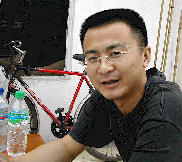
Danny (our guide)
Our hotel, Kunming Camellia, was the only hotel we used which catered mainly for tourists (low budget!).
Kunming
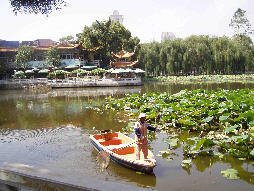
Lake in Ciuhu Park, Kunming. We had lunch nearby.
The following day, we set off to explore the city on hired Chinese city bikes, heavy solid machines with no gears. Danny always proceeds at a brisk pace. At cross roads, etc., I was less bold at plunging into the traffic and got lost off the back twice. Once Danny came haring after me; the second time, I had to use my mobile phone to re-establish contact.
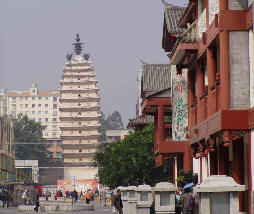
East Pagoda, Kunming
In the evening, we transferred our luggage to bicycle panniers. Our bags were sent to Chengdu to await our arrival at the end of the holiday.
Shangri-La
Early next day, with our boxed bikes, we flew to Shangri-La. The town is at 3,400 m (11,000 feet) above sea level and was formerly called Zhongdian. At the airport, we unpacked and re-assembled the bicycles. We attracted a crowd of about a dozen on-lookers/assistants. Finally, we set off for the Di Qing Hotel.
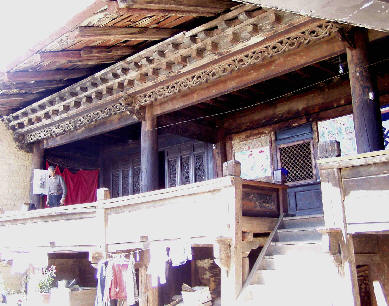
Mr. Abu¡¯s house, typical of the old houses in Shangri-La
We explored the Old Town on foot. It had obviously been allowed to run down but then its tourist potential was realised and most of the old houses were being renovated in the original style. We stopped to admire one of the old houses when an elderly man, Mr. Abu Wandai, invited us in.
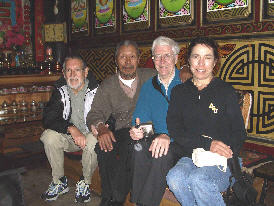
Graham, Jody and me with Mr. Abu
Like most people in Shangri-La, Mr. Abu is of Tibetan origin. His house is over 400 years old.
At lunch, we sampled yak butter tea for the first time - salty and fatty but not undrinkable despite the horror stories.
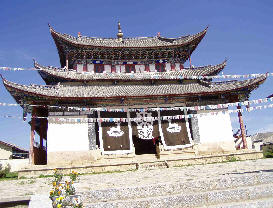
Local temple
¡¡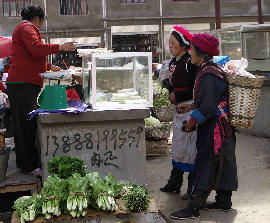
In the market
In the afternoon, we cycled out to Songzanlin monastery.
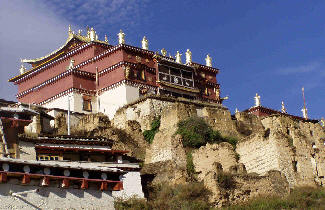
Songzanlin monastery
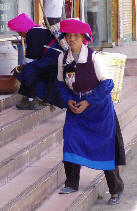
Tibetan woman
Cycling in Rural China: Part 1 | Part 2 | Part 3 | Part 4 | Part 5
Bike China Adventures, Inc.
Home | Guided Bike Tours | Testimonials
| Photos | Bicycle Travelogues
| Products | Info |
Contact Us
Copyright © Bike China Adventures, Inc., 1998-2012. All rights reserved.
